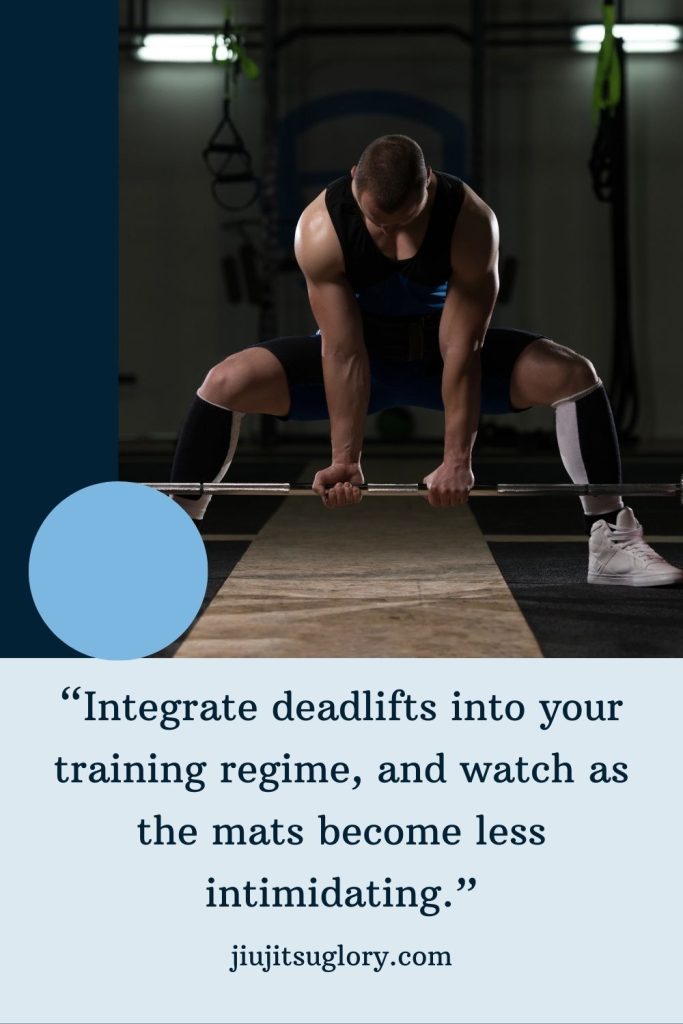Jiu-Jitsu requires a blend of technical skill and physical prowess. One way to enhance your physical strength for jiu-jitsu is through deadlifts, a powerful exercise that targets multiple muscle groups.
This article explores why deadlifts benefit BJJ and how to integrate them into your training.
The Importance of Strength Training in Jiu-Jitsu

In Brazilian jiu-jitsu, strength helps you execute moves like takedowns and maintain control over your opponent.
While technique is crucial, physical strength provides an edge that can make a significant difference during matches.
Integrating strength training with regular BJJ practice can enhance overall performance and effectiveness.
Why Deadlifts for Brazilian Jiu-Jitsu?

Deadlifts are a type of weightlifting exercise that involves lifting a heavy barbell off the ground to the level of the hips and then setting it back down.
They work several key muscle groups, including the back, legs, and core—all critical for Brazilian jiu-jitsu.
Benefits specific to jiu-jitsu include better grip strength for controlling opponents.
In addition, deadlifts enhance the hip drive for explosive movements and increase core stability.
Which is essential for almost every technique and maneuver.
Proper Deadlift Techniques for Jiu-Jitsu Practitioners
Proper technique is necessary to get the most from deadlifting and avoid injuries.
- Start with your feet shoulder-width apart and grip the barbell with both hands.
- Keep your back straight as you lift, and drive upwards from your heels, not your toes.
- Focus on a smooth motion and avoid jerking the bar up.
Remember, proper form ensures you work the right muscles and don’t hurt yourself.
Variations of Deadlifts Suitable for jiu-jitsu
Incorporating different types of deadlifts into your Brazilian Jiu-Jitsu training can help address specific needs and prevent muscle imbalances.
Here are three variations that are particularly beneficial for every practitioner:
Conventional Deadlifts

This classic form of deadlift is a powerhouse for overall strength.
Conventional deadlifts involve lifting a barbell from the ground to hip level and keeping your feet about hip-width apart.
This workout strengthens the lower back, glutes, and hamstrings, crucial for explosive movements like takedowns and sweeps.
Sumo Deadlifts
By positioning your feet wider than your shoulders and your hands inside your legs, the sumo deadlift shifts some of the work to your inner thighs and glutes.
This variation benefits jiu-jitsu athletes by mimicking the lower body positioning used in many grappling stances.
Otherwise, it can enhance your ability to maintain balance and control in wide-leg scenarios.
Romanian Deadlifts
Focusing more on the eccentric phase, Romanian deadlifts are excellent for developing the hamstrings and lower back, which are heavily engaged during guard play and escapes.
Starting from a standing position with the bar at hip level, you lower it by bending at the hips while keeping your legs slightly bent, then lift it again.
This variation is also perfect for improving grip strength, a vital component for effective gi and no-gi grappling.
Adding Deadlifts into Your Jiu-Jitsu Training Program

Deadlifts can be a game-changer for your jiu-jitsu training program, but it’s essential to integrate them thoughtfully to get the most benefit.
Aim to include deadlifts in your strength training sessions twice weekly, allowing ample recovery time between sessions to avoid overtraining.
Start with lighter weights to focus on mastering your form, and gradually increase the weight as your technique improves.
To balance the physical demands of jiu-jitsu and deadlifting, consider doing strength training when your jiu-jitsu training is less intense.
This strategic approach helps enhance muscular strength and endurance without compromising your technique training on the mat.
Addressing Safety and Injury Prevention
When incorporating deadlifts into your training regimen, prioritizing safety is crucial to avoid injuries and ensure sustainable progress.
Begin every deadlifting session with a thorough warm-up that includes dynamic stretches and light cardio to prepare your muscles and joints.
As you perform each lift, focus on keeping your back straight and lifting with your legs rather than your back to protect your spine.
Listen to your body—avoid pushing through pain, and adjust your technique or reduce the weight if necessary.
Regularly engaging in mobility work and using proper lifting techniques prevent injuries and keep your body in optimal condition, enhancing your overall performance in BJJ.
See also: Effective Leg Workouts for Jiu-Jitsu – Must Try!
Conclusion

Deadlifts offer tremendous benefits for Brazilian Jiu-Jitsu practitioners. They enhance physical strength and endurance and improve performance in crucial aspects of the sport.
Integrating deadlifts into your training regimen allows you to develop the power, stability, and resilience needed to excel on the mat.
Whether lifting to improve your takedowns, guard control, or overall grappling ability, deadlifts can be a pivotal part of your development.
See also: 5 Top Knee Braces for Jiu-Jitsu You Should Consider


